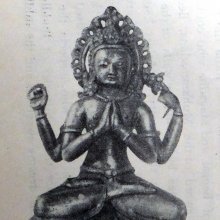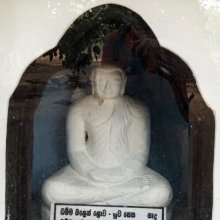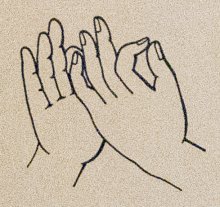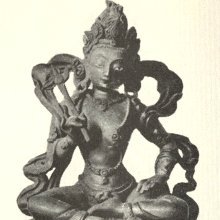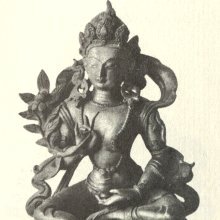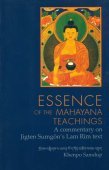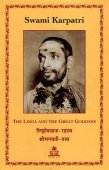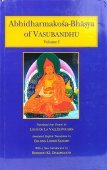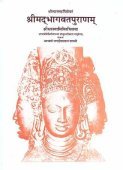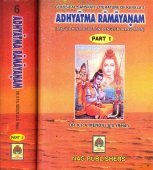Dharma, Dharmā, Dhārma: 63 definitions
Introduction:
Dharma means something in Buddhism, Pali, Hinduism, Sanskrit, Jainism, Prakrit, the history of ancient India, Marathi, Hindi. If you want to know the exact meaning, history, etymology or English translation of this term then check out the descriptions on this page. Add your comment or reference to a book if you want to contribute to this summary article.
Images (photo gallery)
(+30 more images available)
In Hinduism
Shaivism (Shaiva philosophy)
Source: Wisdom Library: Kubjikāmata-tantraDharmā (धर्मा):—Fifth of the eight Mātṛs born from the body of Ātmī, according to the Kubjikāmata-tantra. These eight sub-manifestations (mātṛ), including Dharmā, symbolize the different kinds of souls, as well as the impurities by which these souls are bound (except for Niṣkala or Śiva). They are presided over by the Bhairava Caṇḍa and his consort Brāhmī. Ātmī is the second of the Eight Mahāmātṛs, residing within the Mātṛcakra (third of the five cakras) and represents the ātman.
Source: Shodhganga: Mantra-sādhana: Chapter One of the KakṣapuṭatantraDharma (धर्म, “virtue”) is accomplished by performing mantrasādhana (preparatory procedures) beginning with japamālā using a rosary bead made of lotus seed beads, according to the Kakṣapuṭatantra verse 1.43. Accordingly, “for the accomplishment of all kinds of kāma (love), one should recite a mantra using a rosary made of rudrākṣa beads. For the accomplishment of dharma (virtue), artha (wealth), kāma (love), and mokṣa (liberation), one should recite a mantra using a rosary made of lotus seed beads”.
Source: Shodhganga: Iconographical representations of ŚivaDharma (धर्म) is the name of a deity who received the Sahasrāgama from Bhīma who in turn, received it from Kāla through the mahānsambandha relation, according to the pratisaṃhitā theory of Āgama origin and relationship (sambandha). The sahasra-āgama, being part of the ten Śivabhedāgamas, refers to one of the twenty-eight Siddhāntāgamas: a classification of the Śaiva division of Śaivāgamas. The Śaivāgamas represent the wisdom that has come down from lord Śiva, received by Pārvatī and accepted by Viṣṇu.
Dharma obtained the Sahasrāgama from Bhīma who in turn obtained it from Kāla who in turn obtained it from Sadāśiva through parasambandha. Dharma then, through divya-sambandha transmitted it to the Devas who, through divyādivya-sambandha, transmitted it to the Ṛṣis who finally, through adivya-sambandha, revealed the Sahasrāgama to human beings (Manuṣya). (also see Anantaśambhu’s commentary on the Siddhāntasārāvali of Trilocanaśivācārya)
Source: Brill: Śaivism and the Tantric TraditionsDharma (धर्म) refers to the “qualities (of one’s consciousness)”, according to the Īśvarapratyabhijñāvimarśinī (KSTS vol. 65, 330).—Accordingly, “[...] Thus, due to practicing [this insight], the qualities of His consciousness (saṃvid-dharma), which are aspects of Śakti, fully penetrate [those various levels], causing the [various] powers to arise. But even without practice, in the [rare] case of an instantaneous immersion into That, one obtains the state of liberation-in-life through the process of the direct experience of [the Five Mystic States]: Bliss, Ascent, Trembling, Sleep, and ‘Whirling,’ which means Pervasion”.

Shaiva (शैव, śaiva) or Shaivism (śaivism) represents a tradition of Hinduism worshiping Shiva as the supreme being. Closely related to Shaktism, Shaiva literature includes a range of scriptures, including Tantras, while the root of this tradition may be traced back to the ancient Vedas.
Dharmashastra (religious law)
Source: Google Books: Manusmṛti with the ManubhāṣyaThe author of the Smṛtivivaraṇa describes five kinds of Dharma or Duty:—
- ‘Varṇa-dharma,’ ‘duties pertaining to caste;’
- ‘Āśrama-dharma,’ ‘Duties pertaining to Life-stages,’
- ‘Varṇāśrama-dharma,’ ‘duties pertaining to caste and life-stage’;
- ‘Naimittika-Dharma,’ ‘Occasional Duties,’
- ‘Guṇa-Dharma’ ‘Duties pertaining to qualification.’
Of these, that which proceeds entirely on the basis of caste, and takes no account of age, life-stage or any such circumstances, is called ‘duty pertaining to castes;’
Source: Shodhganga: Facts of society in the ManusamhitaDharma (धर्म):—The term Dharma is derived from the root dhṛ which means to nourish, to uphold, to sustain, to protect and so forth with the affix man. Thus the word comes to imply that which sustains, and protects the creation in a disciplined manner. In the Manusaṃhitā, the word dharma is found in the second śloka of the first chapter for the first time. Here, the sages have addressed Manu as the god (bhagavān) and request him to explain the knowledge of dharma meant for all castes.
The law giver defines the term thus
“It is dharma, which is followed by pious men, well versed in Vedas and ass ented to in their hearts by the virtuous, who are ever exempt from hatred an d inordinate affection.”
In this relation, Kullūka explains dharma as best accomplishment acquiring from the Veda.
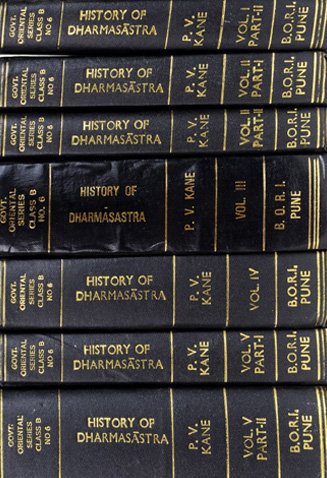
Dharmashastra (धर्मशास्त्र, dharmaśāstra) contains the instructions (shastra) regarding religious conduct of livelihood (dharma), ceremonies, jurisprudence (study of law) and more. It is categorized as smriti, an important and authoritative selection of books dealing with the Hindu lifestyle.
Purana and Itihasa (epic history)
Source: archive.org: Puranic EncyclopediaDharma (धर्म).—A deva who is the abode of all luxuries in life. Birth. This deva broke the right nipple of Brahmā and came out in the form of a human being. Three sons were born to him: Śama, Kāma and Harṣa. Kāma married Rati, Śama, Prāpti and Harṣa, Nandā.* (See full article at Story of Dharma from the Puranic encyclopaedia by Vettam Mani)
Source: archive.org: Shiva Purana - English TranslationDharma (धर्म) was created as a Sādhaka (aspirant) by Brahmā out of his conception (saṅkalpa), according to the Śivapurāṇa 2.1.16:—“[...] I [viz., Brahmā] created many other things as well, but O sage, I was not satisfied. Then O sage, I meditated on Śiva and his consort Ambā and created aspirants (sādhakas). [...] Finally, I created, out of my conception (saṅkalpa), Dharma which is the means for the achievement of everything, [...] O foremost among sages, creating thus, thanks to the favour of Mahādeva, these excellent Sādhakas (e.g., Dharma) I [viz., Brahmā] became contented. Then, O dear one, Dharma, born out of my conception assumed the form of Manu at my bidding and was engaged in activity by the aspirants”.
Source: Cologne Digital Sanskrit Dictionaries: The Purana Index1a) Dharma (धर्म).—With one foot in Kali (truth), the others are austerity, purity and compassion which have disappeared;1 dialogue with Earth in the guise of a bull;2 confusion of, due to different schools of metaphysics.3 The force of Dharma in administration;4 Sanātanadharma lost in Kali.5 Vyavastha done by sages in different periods of Manus.6 Thirty characteristics of.
- 1) Bhāgavata-purāṇa I. 3. 9; 16. 19; 17. 24-5.
- 2) Ib. I. 16. 20-36; 17. 7-16.
- 3) Ib. I. 17. 19-20.
- 4) Brahmāṇḍa-purāṇa III. 50. 53-7.
- 5) Matsya-purāṇa 9. 28-31; 201. 6-8.
- 6) Bhāgavata-purāṇa VII. 11. 8-12.
1b) The father of Nara, married Mūrtī.*
- * Bhāgavata-purāṇa II. 7. 6; XI. 4. 6.
1c) A son of Brahmā, born of the right side of his chest; one of the first five created things for the propagation of people; the first devata who married the thirteen daughters of Dakṣa or the Dākṣāyaṇis (ten: Lakṣmī, Dhṛti, Tuṣṭi, Puṣṭi, Medhā, Kriyā, Buddhi, Lajjā, Vasu, Śānti, Siddhi and Kīrti;1 in the Vaivasvata epoch had for his wives Dākṣāyaṇī and Arundhatī;2 father of Kāma and Lakṣmī;3 presented Pṛthu with a garland of fame.4
- 1) Bhāgavata-purāṇa III. 12. 25; IV. I. 48-50; Brahmāṇḍa-purāṇa II. 9. 1, 49-50; IV. 1. 40; Matsya-purāṇa 3. 10; 4. 34 and 55; 5. 13; 146. 16; Va. 1. 69; 10. 26; 100. 43; Viṣṇu-purāṇa I. 7. 24, 28-31; 15. 77, 103. Vāyu-purāṇa 63. 41; 66. 2; 76. 3.
- 2) Matsya-purāṇa 203. 1-2.
- 3) Ib. 171. 42.
- 4) Bhāgavata-purāṇa IV. 15. 15; VI. 6. 2.
1d) A constellation which goes round Dhruva keeping him to the right.*
- * Bhāgavata-purāṇa IV. 9. 21; V. 23. 5; Brahmāṇḍa-purāṇa II. 21. 176.
1e) Married Sūnṛtā and had sons like Satyasena and others.*
- * Bhāgavata-purāṇa VIII. 1 25.
1f) The god of righteousness and appointed father of Yudhiṣṭhira;1 father of Dharmavratā, the future Śila at Gayā;2 did not comprehend Hari's māya.3
- 1) Bhāgavata-purāṇa IX. 22. 27; Matsya-purāṇa 46. 9; 50. 49; 171. 26; Vāyu-purāṇa 96. 153; Viṣṇu-purāṇa IV. 14. 35; 20. 40.
- 2) Vāyu-purāṇa 107. 2. 111. 23.
- 3) Bhāgavata-purāṇa IX. 4. 57.
1g) The son of Gāndhāra and father of Dhṛta (Ghṛta: Viṣṇu-purāṇa).*
- * Bhāgavata-purāṇa IX. 23. 15; Brahmāṇḍa-purāṇa III. 74. 10; Matsya-purāṇa 48. 8; Vāyu-purāṇa 19. 10; Viṣṇu-purāṇa IV. 17. 4.
1h) A son of Haihaya, and father of Netra.*
- * Bhāgavata-purāṇa IX. 23. 22.
1i) A son of Pṛthuśravas and father of Uśanas.*
- * Bhāgavata-purāṇa IX. 23. 34.
1j) Caturmūrti in Benares.*
- * Matsya-purāṇa 183. 41.
1k) A Devaṛṣi and the 14th Vedavyāsa; wife Lakṣmi and daughter Sūnṛtā; married ten daughters of Dakṣa; father of 12 Sādhyas, 8 Vasavas, 10 Viśvedevas, of Maruts, of Bhānus, of Muhūrtas and so on. Father of Yudhiṣṭhira; cursed by Māṇḍavya the sage.*
- * Vāyu-purāṇa 10. 26; 63. 41; 66. 2; 76. 3. Brahmāṇḍa-purāṇa II. 9. 1, 49-50.
1l) Manifold and subtle; to understand the truth is difficult; hence it is not possible to give a definite lead in the Vedic laws; hence sages do not attach weight to dāna and yajña but to sanātanadharma which leads to svarga; is knowledge of the Śrauta Smārta dharma and following of Varṇāśrama for attainment of heaven; Iṣṭaprāpaka dharma introduced by the Ācāryas.1 Consists of ten things: begging food, non-theft, purity, disinterestedness, activity, sympathy, non-injury, avoidance of anger, service of the guru, truthfulness;2 of four pādas;3 course of, in the four yugas.4
- 1) Vāyu-purāṇa 57. 112-8; 59. 21, 28.
- 2) Brahmāṇḍa-purāṇa II. 7. 178; Vāyu-purāṇa 8. 186.
- 3) Ib. 23. 81-2.
- 4) Ib. 58. 5.
1m) A son of Dīrghatapas.*
- * Vāyu-purāṇa 92. 7.
1n) One of the ten Sutapa gaṇas.*
- * Vāyu-purāṇa 100. 15.
1o) A son of Suvrata, and father of Śuśravas.*
- * Viṣṇu-purāṇa IV. 23. 6.
1p) A Sutapa god.*
- * Brahmāṇḍa-purāṇa IV. 1. 14.
1q) A son of Raucya Manu.*
- * Brahmāṇḍa-purāṇa IV. 1. 104.
1r) A Vasu; wife Manoharā; father of a number of sons.*
- * Viṣṇu-purāṇa I. 15. 110, 113.
1s) A son of Haihaya, and father of Dharmanetra.*
- * Viṣṇu-purāṇa IV. 11. 8.
Dharma (धर्म).—Purāṇic sources relate the story of Dharma becoming a four footed bull and the porter of Śiva. It is narrated by Lakkaṇṇadaṇḍeśa, author of the Śivatattvacintāmaṇi and minister of Devarāya II of the Karnāṭaka Empire. In the 3rd sandhi, he writes that Dharma is Nandin, and Śiva made him his mount. In the published edition of the Liṅgapurāṇa the story of Nandin is not there. The occurrence of this story in the Śivatattvacintāmaṇi, obviously, makes us to deduce that perhaps, there must have been another version of the Liṅgapurāṇa in Karnāṭaka not available to us to-day.
Source: JatLand: List of Mahabharata people and placesDharma (धर्म) is a name mentioned in the Mahābhārata (cf. I.60.12) and represents one of the many proper names used for people and places. Note: The Mahābhārata (mentioning Dharma) is a Sanskrit epic poem consisting of 100,000 ślokas (metrical verses) and is over 2000 years old.
Source: Shodhganga: The saurapurana - a critical study1) Dharma (धर्म) obtained thirteen daughters from Dakṣa, according to the Vaṃśa (‘genealogical description’) of the 10th century Saurapurāṇa: one of the various Upapurāṇas depicting Śaivism.—Accordingly, Ākūti was married to Ruci and Prasūti to Dakṣa. Dakṣa produced in Prasūti twenty-four daughters. [...] [Dakṣa gave thirteen daughters Śraddhā and others to Dharma.]. [...] From Bhṛgu through Khyāti, Lakṣmī (the beloved of Nārāyaṇa), Dhātā and Vidhātā were born. Dhātā and Vidhātā became the Sons-in-law of Meru marrying Āyati and Niyati respectively.
2) Dharma (धर्म) obtained ten daughters from Dakṣa in another account of the Vaṃśa (‘genealogical description’) in the Saurapurāṇa.—Accordingly, Dakṣa is spoken of as busy in creation. Ordered by Brahmā he creates the Sages, gods, demons etc. In order to have maithuni sṛṣṭi Dakṣa gets married to Asikni, the daughter of Prajāpati Viraṇa and begot sixty daughters. [He gave ten daughters to Dharma in marriage] [...] The ten wives of Dharma are Sādhyā, Viśvā, Saṃkalpā, Muhūrtā, Arundhatī, Marutvatī, Vasu, Bhūnu, Lambā and Jāmī.
3) Dharma (धर्म) also refers to the son of Haihaya and the grandson of Śatajit, according to the Vaṃśānucarita section of the Saurapurāṇa.—Accordingly, [...] Yadu had a famous son known as Śatajit and the latter begot Haihaya. Dharma was the son of Haihaya and his son was Dharmanetra.

The Purana (पुराण, purāṇas) refers to Sanskrit literature preserving ancient India’s vast cultural history, including historical legends, religious ceremonies, various arts and sciences. The eighteen mahapuranas total over 400,000 shlokas (metrical couplets) and date to at least several centuries BCE.
Vaisheshika (school of philosophy)
Source: Wisdom Library: VaiśeṣikaDharma (धर्म, “merit”) is one of the additional guṇas (‘qualities’) added by Praśastapāda, on top of the seventeen guṇas in the Vaiśeṣika-sūtras. These guṇas are considered as a category of padārtha (“metaphysical correlate”). These padārthas represent everything that exists which can be cognized and named. Together with their subdivisions, they attempt to explain the nature of the universe and the existence of living beings.

Vaisheshika (वैशेषिक, vaiśeṣika) refers to a school of orthodox Hindu philosophy (astika), drawing its subject-matter from the Upanishads. Vaisheshika deals with subjects such as logic, epistemology, philosophy and expounds concepts similar to Buddhism in nature
Mīmāṃsā (school of philosophy)
Source: Srimatham: Mīmāṃsa: The Study of Hindu ExegesisDharma (धर्म) refers to “right action”.—The primary purpose of Mīmāṃsa is to establish the nature of right action (Dharma). The basic premise of Mīmāṃsa is that action is fundamental to the human condition. Without application, knowledge is vain; without action, happiness is impossible; without action human destiny cannot be fulfilled; therefore, right action (Dharma) is the sine-qua-non of a meaningful life on earth.
Jaimini defines Dharma as: codaṇā-lakṣaṇaḥ arthaḥ dharmaḥ.—“Dharma is that which leads to the highest common good (śreyas) and is distinguished by Vedic injunctions”. Dharma is “right living” defined by the practice of universal ethics and personal morals. “Dharma” cannot be known through empirical means such as cognition. It can be known only either through intuition or through a impersonal source of knowledge. The problem with relying on reason or intuition is that individuals will come to differing conclusions about what the ultimate nature of the “Good” is. There are endless controversies on most if not all ethical issues by “experts” who take one side or the other. The best and most universal source of Dharma therefore, would be an “impersonal” source such as the Vedas.
Dharma is that act which is enjoined by the Veda through its injunctive passages and which is conducive to the happiness of all beings.
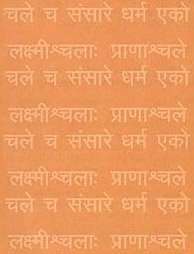
Mimamsa (मीमांसा, mīmāṃsā) refers to one of the six orthodox Hindu schools of philosophy, emphasizing the nature of dharma and the philosophy of language. The literature in this school is also known for its in-depth study of ritual actions and social duties.
Vyakarana (Sanskrit grammar)
Source: Shodhganga: Vaiyākaraṇabhūṣaṇasāra: a critical studyDharma (धर्म).—A property which qualifies a thing or a letter or a word.
Source: Wikisource: A dictionary of Sanskrit grammarDharma (धर्म).—Defined as ऋषिसंप्रदाय (ṛṣisaṃpradāya), the traditional practices laid down by the sages for posterity; cf.केवलमृषिसंप्रदायो धर्म इति कृत्वा याज्ञिक्राः शास्त्रेण अनुविदधते (kevalamṛṣisaṃpradāyo dharma iti kṛtvā yājñikrāḥ śāstreṇa anuvidadhate) M. Bh. I. 1. Ahnika I ; cf also धर्मशास्त्रं (dharmaśāstraṃ) in एवं च कृत्वा धर्मशास्त्रं प्रवृत्तम् (evaṃ ca kṛtvā dharmaśāstraṃ pravṛttam) M. Bh. on P. I. 2.64, as also धर्मसूत्रकाराः (dharmasūtrakārāḥ) in नैवेश्वर आज्ञापयति नापि धर्मसूत्रकाराः पठन्ति अपवादैरुत्सर्गा बाध्यन्तामिति (naiveśvara ājñāpayati nāpi dharmasūtrakārāḥ paṭhanti apavādairutsargā bādhyantāmiti) M. Bh. on I. l.47; (2) religious merit, cf. धर्मोपदे-शनमिदं शास्त्रमस्मिन्ननवयवेन शास्त्रार्थः संप्रतीयते (dharmopade-śanamidaṃ śāstramasminnanavayavena śāstrārthaḥ saṃpratīyate), M. Bh. on P. VI. I. 84, cf also ज्ञाने घमै इति चेत्तथा (jñāne ghamai iti cettathā)Sधर्मः (dharmaḥ) M. Bh. I. 1. Ahnika l ; ' 3) property possessed by a thing or a letter or a word. e. g. वर्णधर्म (varṇadharma); cf Kas. on P. I. 2.29; cf also Kas. on P. II. 1, 55, II. 3.33, VIII. 1. 4. cf. also R. Pr. III. 8, 13 XIV. 1 etc.: (4) the characteristic of being in a substance; in the phrase अयं घटः (ayaṃ ghaṭaḥ) the dharma viz.घटत्व (ghaṭatva) is predicated of this (इदम् (idam)) or, in other words the designation pot (घटसंज्ञा (ghaṭasaṃjñā)) is the predication; the explanation in short, can be given as घटत्ववान् इदं-पदार्थः (ghaṭatvavān idaṃ-padārthaḥ) or घटाभिन्नः इदंपदार्थः (ghaṭābhinnaḥ idaṃpadārthaḥ)

Vyakarana (व्याकरण, vyākaraṇa) refers to Sanskrit grammar and represents one of the six additional sciences (vedanga) to be studied along with the Vedas. Vyakarana concerns itself with the rules of Sanskrit grammar and linguistic analysis in order to establish the correct context of words and sentences.
Jyotisha (astronomy and astrology)
Source: Wisdom Library: Brihat Samhita by VarahamihiraDharma (धर्म) refers to “charity”, according to the Bṛhatsaṃhitā (chapter 16) (“On the planets—graha-bhaktiyoga”), an encyclopedic Sanskrit work written by Varāhamihira mainly focusing on the science of ancient Indian astronomy astronomy (Jyotiṣa).—Accordingly, “[...] Jupiter also presides over elephants, horses, priests, rulers, ministers, marriages and health; over mercy, truthfulness, cleanliness, religious observances; over learning, gifts and charity (dharma); over citizens, richmen, grammarians, Vedic students, sorcerers, lawyers, the ensigns of royalty—the umbrella, the flag-staff, the Cāmara and the like; over Śaileyaka, Mānsī, Tagara, Kuṣṭha, quicksilver, salt, beans, sweet flavour, wax and Coraka”.
Source: Wikibooks (hi): Sanskrit Technical TermsDharma (धर्म).—The Hindu doctrine of sacred law or righteousness; the moral and religious duties prescribed for humans. Note: Dharma is a Sanskrit technical term used in ancient Indian sciences such as Astronomy, Mathematics and Geometry.

Jyotisha (ज्योतिष, jyotiṣa or jyotish) refers to ‘astronomy’ or “Vedic astrology” and represents the fifth of the six Vedangas (additional sciences to be studied along with the Vedas). Jyotisha concerns itself with the study and prediction of the movements of celestial bodies, in order to calculate the auspicious time for rituals and ceremonies.
Pancaratra (worship of Nārāyaṇa)
Source: archive.org: Isvara Samhita Vol 5Dharma (धर्म) or Dharmamudrā is the name of a mudrā described in the Īśvarasaṃhitā 50-53.—Accordingly, “the two hands are to be kept apart and then the index fingers are to be joined face to face; leaving this formation for the two middle fingers; the ring fingers shall be left out, this shall be done to the two little fingers. This shall be done to the two thumbs while forming each. These four mudrās are for dharma and others and adharma and others. The lotus that exists above them (dharma and others) was described before with mantras”.
Mūdra (eg., Dharma-mudrā) is so called as it gives joy to the tattvas in the form of karman for those who offer spotless worship, drive out the defects which move about within and without and sealing up of what is done.
Source: archive.org: Isvara Samhita Vol 1Dharma (धर्म) refers to one of the various Vibhava manifestations according to the Īśvarasaṃhitā 24.246-249.—Accordingly, “it is all pervading dharma which is of a general kind, is spotless, having no beginning and no destruction, which had to obtain without the favour of the enlightened. Listen to its gross form so as to get at it; it is like the hill of snow of pleasant countenance, having four hands, bearing kāma and artha under the pretext of śaṅkha and padma, which (kāma and artha) offer with knowledge to those who adopt the path of good. He (dharma) shall bethought of as having the hand offering boons, holding white rosary garland”.
These Vibhavas (e.g., Dharma) represent the third of the five-fold manifestation of the Supreme Consciousness the Pāñcarātrins believe in. Note: Śaṅkha and Padma are the two treasures (nidhis) which dharma bears. These are intended to help those people who pursue the right course conduct in order that the pursuits (kāma and artha) would have been fruitfully taken up by them. Kāma means desires in life. Artha means wealth or economic condition. Money is required to pursue these. The two measures Śaṅkha and Padma are thus helpful for them in pursuing these goals .The Viṣvaksena-aṃhitā (XX 87-88) mentions conch, discus and yellow cloth while describing dharma.
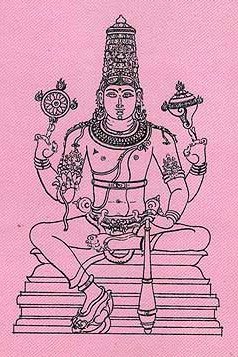
Pancaratra (पाञ्चरात्र, pāñcarātra) represents a tradition of Hinduism where Narayana is revered and worshipped. Closeley related to Vaishnavism, the Pancaratra literature includes various Agamas and tantras incorporating many Vaishnava philosophies.
Arthashastra (politics and welfare)
Source: Knowledge Traditions & Practices of India: Indian Ethics: Individual and SocialDharma (धर्म).—In Indian tradition, the concept of ṛta (cosmic order) gave rise to the idea of dharma. The term dharma here does not mean mere religion; it stands for duty, obligation and righteousness. It is a whole way of life in which ethical values are considered supreme and everyone is expected to perform his or her duty according to his or her social position and station in life. In Buddhism, the word dhamma is used, which is the Pāli equivalent of the Sanskrit word dharma. The guidelines and rules regarding what is considered as appropriate behaviour for human beings are prescribed in the Dharma Śāstras. These are sociological texts that tell us about our duties and obligations as individuals as well as members of society.
The concept of right and wrong is the core of the Mahābhārata which emphasizes, among others, the values of non-violence, truthfulness, absence of anger, charity, forgiveness and self realization. It is only by performing one’s righteous duties or dharma that one can hope to attain the supreme path to the highest good. It is dharma alone that gives both prosperity (abhyudaya) and the supreme spiritual good (niśryas).

Arthashastra (अर्थशास्त्र, arthaśāstra) literature concerns itself with the teachings (shastra) of economic prosperity (artha) statecraft, politics and military tactics. The term arthashastra refers to both the name of these scientific teachings, as well as the name of a Sanskrit work included in such literature. This book was written (3rd century BCE) by by Kautilya, who flourished in the 4th century BCE.
Kavya (poetry)
Source: Wisdom Library: KathāsaritsāgaraDharma (धर्म) is the name of an ancient king from Dakṣiṇāpatha (the Deccan), according to the twenty-fourth story of the Vetālapañcaviṃśati in the Kathāsaritsāgara, chapter 98. Accordingly, “... there was in the Deccan a king of a small province, who was named Dharma; he was the chief of virtuous men, but he had many relations who aspired to supplant him”.
The story of Dharma is mentioned in the Vetālapañcaviṃśati (twenty-five tales of a vetāla) which is embedded in the twelfth book of the Kathāsaritsāgara (‘ocean of streams of story’). The main book is a famous Sanskrit epic detailing the exploits of prince Naravāhanadatta in his quest to become the emperor of the vidyādharas (celestial beings). The Kathā-sarit-sāgara is is explained to be an adaptation of Guṇāḍhya’s Bṛhatkathā which consisted of 100,000 verses and in turn forms part of an even larger work containing 700,000 verses.

Kavya (काव्य, kavya) refers to Sanskrit poetry, a popular ancient Indian tradition of literature. There have been many Sanskrit poets over the ages, hailing from ancient India and beyond. This topic includes mahakavya, or ‘epic poetry’ and natya, or ‘dramatic poetry’.
Nyaya (school of philosophy)
Source: Shodhganga: A study of Nyāya-vaiśeṣika categoriesDharma (धर्म, “merit”) and Adharma (demerit) refers to two of the twenty-four guṇas (qualities) according to Praśastapāda and all the modern works on Nyāya-Vaiśeṣika.—Dharma (merit) and adharma (demerit) constitute adṛṣṭa (destiny). Radhakrishnan says “Dharma and adharma are qualities of the soul by virtue of which it enjoys happiness or suffers misery. Adṛṣṭa is the unseen power produced by souls and things, which brings about the cosmic order and enables selves to reap the harvest of their past experiences”.
Praśastapāda points out that dharma is a quality of puruṣa i.e., the self. It produces happiness and liberation. It is caused by the contact of the self with the antaḥkaraṇa (inner organ), conditioned by pure thoughts and decisions. It is not perceptible by the senses and is destroyed by the experience of final happiness. Demerit (adharma), on the other hand, produces undesirable results. It is produced by doing prohibited action, not performing prescribed duties, neglect and impurity of motives. Viśvanātha describes dharma as that which leads to heaven etc. In his view, dharma consists of actions like bath in the gangas and sacrifices. Similarly, adharma is the cause of hell etc. It is produced by such actions which are condemnable. Viśvanātha also maintains that these two are produced by subtle impressions (vāsana) and are destroyed by knowledge also.
Dharma and adharma are the special qualities of the self and are imperceptible by the senses. According to Annaṃbhaṭṭa, among the aforementioned eight special qualities of the self, buddhi, icchā and prayatna are both eternal and noneternal. In case of īśvara these qualities are eternal and in case of the jīva these are non-eternal.

Nyaya (न्याय, nyaya) refers to a school of Hindu philosophy (astika), drawing its subject-matter from the Upanishads. The Nyaya philosophy is known for its theories on logic, methodology and epistemology, however, it is closely related with Vaisheshika in terms of metaphysics.
Vaishnavism (Vaishava dharma)
Source: Pure Bhakti: Bhagavad-gita (4th edition)Dharma (धर्म) refers to “from the verbal root dhṛ, to sustain. Literally, ‘that which sustains’; (1) The natural, characteristic function of a thing; that which cannot be separated from its nature (2) Religion in general (3) The socio-religious duties prescribed in the scriptures for different classes of persons in the varṇāśrama system (4) One’s fixed occupation in relation to Śrī Kṛṣṇa”. (cf. Glossary page from Śrīmad-Bhagavad-Gītā).
Source: Pure Bhakti: Bhajana-rahasya - 2nd EditionDharma (धर्म) refers to:—(1) religion in general; (2) the socio-religious duties prescribed in the scriptures for different classes of persons in the varṇāśrama system. (cf. Glossary page from Bhajana-Rahasya).
Source: Pure Bhakti: Brhad BhagavatamrtamDharma (धर्म) refers to:—Constitutional nature; individual duty; principles of religious conduct; religiosity. (cf. Glossary page from Śrī Bṛhad-bhāgavatāmṛta).

Vaishnava (वैष्णव, vaiṣṇava) or vaishnavism (vaiṣṇavism) represents a tradition of Hinduism worshipping Vishnu as the supreme Lord. Similar to the Shaktism and Shaivism traditions, Vaishnavism also developed as an individual movement, famous for its exposition of the dashavatara (‘ten avatars of Vishnu’).
Ayurveda (science of life)
Source: gurumukhi.ru: Ayurveda glossary of termsDharma (धर्म):—Righteousness, justice, duty, obligations, dispostion, distinctive quality , religious observence etc. One of the four Purusharta’s (values or goals of life) according to hindus. It is inferred by results of good conduct of a person which provides heaven and happiness is treated as dharma. Contrary to this Adharma.

Āyurveda (आयुर्वेद, ayurveda) is a branch of Indian science dealing with medicine, herbalism, taxology, anatomy, surgery, alchemy and related topics. Traditional practice of Āyurveda in ancient India dates back to at least the first millenium BC. Literature is commonly written in Sanskrit using various poetic metres.
Yoga (school of philosophy)
Source: ORA: Amanaska (king of all yogas): A Critical Edition and Annotated Translation by Jason BirchDharma (धर्म) refers to “meritorious actions”, according to the Viṣṇudharma verse 96.25-26.—Accordingly, while discussing the cessation of mind: “Since [duality is based on mental activity and non-duality on the ultimate truth], the activities of mind, which are caused by meritorious (dharma) and unmeritorious actions, should be stopped. Because of their cessation, duality does not arise. This duality, which consists of whatever is moving and unmoving, is an object of mind. When the mind has become without thoughts, then one obtains the absence of duality”.

Yoga is originally considered a branch of Hindu philosophy (astika), but both ancient and modern Yoga combine the physical, mental and spiritual. Yoga teaches various physical techniques also known as āsanas (postures), used for various purposes (eg., meditation, contemplation, relaxation).
General definition (in Hinduism)
Source: Wisdom Library: HinduismDharma (धर्म, “eternal law”):—He is the father of Agni, one of the most important Vedic gods representing divine illumination. The wife of Dharma is Vasubhārya.
Source: Shodhganga: The significance of the mūla-berasDharma (धर्म) refers to the “code of life” upon whose conduct Hinduism is based. Hinduism is a way of life and is based on the practice of dharma, the code of life. The ultimate objective of religion is the realization of truth by getting united with the Supreme Being, Paramātman. There are six recognized philosophical systems, which trace their origin more or less directly to the Upanishads. The systems are known as the Vedānta, founded by Vyāsa; the Mīmāmsa, founded by Kapila; the Yogā, founded by Patanjali; the Nyāya, founded by Gotama; and the Vaiśeshika founded by Kanada. The teachings of these philosophical systems form the basic tenets of Hindu religion. The two great groups are the Vaiṣṇavites and the Śivaites. Both the sects strictly follow the ancient Hindu rules of conduct which came to be known as dharma.
In Buddhism
Mahayana (major branch of Buddhism)
Source: Wisdom Library: Maha Prajnaparamita Sastra1) Dharma (धर्म):—The search for the Dharma by means of the non-apprehension of all the teachings. – The bodhisattva seeks the Dharma with resolutions associated with omniscience and [hence] does not fall to the rank of śrāvaka or pratyekabuddha.
There are three kinds of Dharma:
- The supreme Dharma of all (sarveṣu-anuttara), i.e., nirvāṇa.
- The means of attaining nirvāṇa (nirvāṇa-prāpti-upāya), i.e., the noble eightfold Path (āryāṣṭāṅgamārga).
- All good words (subhāṣita), truthful words (satyavacana) promoting the eightfold noble Path.
To seek the Dharma (dharmaparyeṣṭi) is to write it, to recite it, to study it and to meditate on it. These texts heal the mental illnesses (cittavyādhi) of beings. The bodhisattva sacrifices his life to gather together these text-remedies.
2) Dharma (धर्म) refers to “things” according to the 2nd century Mahāprajñāpāramitāśāstra (chapter XXV).—There are two kinds of things (dharmas): i) mental things (citta-dharma), ii) extra-mental things (acitta-dharma).
a) Among the extra-mental things (acitta-dharma), some are inner (ādhyātmika) and others are outer (bāhya). Cold (śīta), heat (uṣṇa) wind (anila), rain (varṣa), etc., are outer; hunger (kṣudha), thirst (pipāsa), old age (jarā), sickness (vyādhi), death (maraṇa), etc., are inner: all the categories of this type are extra-mental.
b) Among the mental things (citta-dharma), there are two types: i) anger (krodha, vyāpāda), sadness (daurmanasya), doubt (saṃśaya), etc.; ii) lust (rāga), pride (abhimāna), etc.: these two categories are mental things.
Furthermore, all Dharmas are grouped into two categories: i) material Dharmas (rūpidharma), and ii) non-material dharmas (arūpidharma), Material dharmas can be divided down to the subtle atom (paramāṇu) and endless dispersion, as we have seen in regard to the refutation of the gift given in the chapter on Danāpāramitā. Non-material Dharmas are not cognized by the five faculties. Therefore it is by means of considering the moment of birth-duration-destruction of the mind that we know that the mind (citta) is composed of parts (sabhāga).
Source: Wisdom Library: Mahayana BuddhismDharma (धर्म, “phenomena”).—According to the classical Mādhyamaka thinkers, all phenomena (dharmas) are empty (śūnya) of "nature," a "substance" or "essence" (svabhāva) which gives them "solid and independent existence," because they are dependently co-arisen. But this "emptiness" itself is also "empty": it does not have an existence on its own, nor does it refer to a transcendental reality beyond or above phenomenal reality.
Source: academia.edu: A Study and Translation of the GaganagañjaparipṛcchāDharma (धर्म) refers to “truth”, according to the Gaganagañjaparipṛcchā: the eighth chapter of the Mahāsaṃnipāta (a collection of Mahāyāna Buddhist Sūtras).—Accordingly, “[...] Then again, the Bodhisattva, the great being Gaganagañja uttered these verses to that Bodhisattva, the great being Guṇarājaprabhāsa: ‘(29) [...] The one who delights in the well done (sukṛta) and perfected dharma, who is free from the twofold grasping (dvayagrāha) of truth or untruth (dharma-adharma), and who constantly takes pleasure in the dharma through the excellent concentration, him I ask about the of the space-like subject of mind. [...]’”.

Mahayana (महायान, mahāyāna) is a major branch of Buddhism focusing on the path of a Bodhisattva (spiritual aspirants/ enlightened beings). Extant literature is vast and primarely composed in the Sanskrit language. There are many sūtras of which some of the earliest are the various Prajñāpāramitā sūtras.
Theravada (major branch of Buddhism)
Source: Wikipedia: AbhidharmaDharmas (Pali: dhammas):—For the Abhidharmikas, the ultimate components of existence, the elementary constituents of experience were called dharmas. These dharmas were seen as the ultimate entities or momentary events which make up the fabric of people's experience of reality. The conventional reality of substantial objects and persons is merely a conceptual construct imputed by the mind on a flux of dharmas. However, dharmas are never seen as individually separate entities, but are always dependently conditioned by other dharmas in a stream of momentary constellations of dharmas, constantly coming into being and vanishing, always in flux.
The four categories of dharmas in the Theravada Abhidhamma are:
- citta (Mind, Consciousness, awareness)
- cetasika (mental factors, mental events, associated mentality), there are 52 types
- rūpa — (physical occurrences, material form), 28 types
- nibbāna — (Extinction, cessation). This dharma is unconditioned it neither arises nor ceases due to causal interaction.
Theravāda is a major branch of Buddhism having the the Pali canon (tipitaka) as their canonical literature, which includes the vinaya-pitaka (monastic rules), the sutta-pitaka (Buddhist sermons) and the abhidhamma-pitaka (philosophy and psychology).
Tibetan Buddhism (Vajrayana or tantric Buddhism)
Source: Wisdom Library: Tibetan BuddhismDharma (धर्म) is the name of a Pratyekabuddha mentioned as attending the teachings in the 6th century Mañjuśrīmūlakalpa: one of the largest Kriyā Tantras devoted to Mañjuśrī (the Bodhisattva of wisdom) representing an encyclopedia of knowledge primarily concerned with ritualistic elements in Buddhism. The teachings in this text originate from Mañjuśrī and were taught to and by Buddha Śākyamuni in the presence of a large audience (including Dharma).
Source: archive.org: The Indian Buddhist IconographyDharma (धर्म, “nature”) or Dharmapratisaṃvit refers to one of four Pratisaṃvit Goddesses, as commonly depicted in Buddhist Iconography, and mentioned in the 11th-century Niṣpannayogāvalī of Mahāpaṇḍita Abhayākara.—Her Colour is whitish-red; her Symbol is the goad and noose; she has two arms.
Dharma is described in the Niṣpannayogāvalī (dharmadhātuvāgīśvara-maṇḍala) as follows:—
Source: academia.edu: The Structure and Meanings of the Heruka Maṇḍala“On the Eastern gate there is Dharma-Pratisaṃvit of whitish-red colour, holding in her two hands the goad and the noose marked with the thunderbolt”.
[A statue of this obscure Buddhist deity is found in the Chinese collection.]
Dharma (धर्म) or Dharmapuṭa refers to the second layer of the Herukamaṇḍala: a large-scale and elaborate maṇḍala of Heruka, consisting of 986 deities, as found in the Ḍākārṇava chapter 15.—The Herukamaṇḍala consists of four layers (puṭa) consisting of concentric circles (cakra, totally one lotus at the center and 12 concentric circles, that is, 13 circles in total).
The Second layer (dharma-puṭa) consists of:
- The space circle (ākāśacakra),
- The wind circle (vāyucakra),
- The earth circle (medinīcakra).

Tibetan Buddhism includes schools such as Nyingma, Kadampa, Kagyu and Gelug. Their primary canon of literature is divided in two broad categories: The Kangyur, which consists of Buddha’s words, and the Tengyur, which includes commentaries from various sources. Esotericism and tantra techniques (vajrayāna) are collected indepently.
General definition (in Buddhism)
Source: Wisdom Library: Dharma-samgrahaDharma (धर्म) is the second of the “three treasures” (triratna) defined in the Dharma-saṃgraha (section 1). The Dharma-samgraha (Dharmasangraha) is an extensive glossary of Buddhist technical terms in Sanskrit (e.g., triratna and dharma). The work is attributed to Nagarjuna who lived around the 2nd century A.D.
Dharma or dharmāyatana also represents one of the “twelve sense spheres” (āyatana), one of the “eighteen elements” (dhātu).
Dharma also refers to one of the “six spheres” (ṣaḍviṣaya) as defined in the Dharma-saṃgraha (section 33).
Dharma also refers to one of the “four analytical knowledges” (pratisaṃvid) as defined in the Dharma-saṃgraha (section 51).
Dharma or Dharmadhāraṇī refers to “the rentention of the dharma” and represents the “four retentions” (dhāraṇī) as defined in the Dharma-saṃgraha (section 52).
Dharma or Dharmānusmṛti refers to one of the “six recollections” (anusmṛti) as defined in the Dharma-saṃgraha (section 54).
Dharma or Dharmacakṣus refers to one the “five eyes” (cakṣus) as defined in the Dharma-saṃgraha (section 65).
Dharma or Dharmavaśitā refers to the “mastery of dharma” and represents one of the “ten masteries of the Bodhisattvas” (vaśitā) as defined in the Dharma-saṃgraha (section 74).
Dharma or Dharmamātsarya refers to “selfishness regarding dharma” and represents one of the “five selfishnesses” (mātsarya) as defined in the Dharma-saṃgraha (section 78).
Dharma or Dharmayajñāna refers to the “knowledge of dharma” and represents one of the “ten knowledges” (jñāna) as defined in the Dharma-saṃgraha (section 93).
Dharma or Dharmadāna also refers to the “gift of the dharma” and represents one of the “three kinds of gifts” (dāna) as defined in the Dharma-saṃgraha (section 105):.
Source: WikiPedia: BuddhismThe word dharma is generally translated into English as law. The word "dharma" can also be translated as "the teachings of the Buddha".
The term Dharma is an Indian spiritual and religious term, that means ones righteous duty or any virtuous path in the common sense of the term.
In Indian languages it contextually implies ones religion. Throughout Indian philosophy, Dharma is presented as a central concept that is used in order to explain the "higher truth" or ultimate reality of the universe.
The antonym of dharma is adharma meaning unnatural or immoral.
Source: Shambala Publications: GeneralDharma Skt., lit, “carrying, holding” (Pali, dhamma; Chin., fa; Jap., hō or datsuma); central notion of Buddhism, used in various meanings.
- The cosmic law, the “great norm,” underlying our world; above all, the law of karmically determined rebirth.
- The teaching of the Buddha, who recognized and formulated this “law”; thus the teaching that expresses the universal truth. The dharma in this sense existed already before the birth of the historical Buddha, who is no more than a manifestation of it. It is in the dharma in this sense that a Buddhist takes refuge (trisharana).
- Norms of behavior and ethical rules (shīla).
- Manifestation of reality, of the general state of affairs; thing, phenomenon.
- Mental content, object of thought, idea—a reflection of a thing in the human mind.
- Term for the so-called factors of existence, which the Hīnayāna considers as building blocks of the empirical personality and its world.
Dharma (धर्म).—For Kumārila, dharma is ultimate happiness for human being and final goal that is only prescribed and regulated by Vedic injunction. Human being never know dharma by the power of their own, not without Veda. Thus, the all debates of Kumārila can be concisely summarized “through Vedic injunction human beings only know dharma”. Therefore, it is reasonable for Kumārila that because human beings have limited ability there is no omniscient being in terms of real.
In Jainism
General definition (in Jainism)
Source: Wisdom Library: Jainism1) Dharma (धर्म):—The fifteenth Tīrthaṅkara (Janism recognizes 24 such teachers or Siddhas). He is also known as Dharmanātha. His colour is red (rakta), according to Aparājitapṛcchā (221.5-7). His height is 45 dhanuṣa (a single dhanuṣa (or, ‘bow’) equals 6 ft), thus, roughly corresponding to 82 meters. His emblem, or symbol, is a Vajra.
Dharma’s father is Bhānu and his mother is Suvratā. It is an ancient Jain practice to worship the Tīrthaṅkara’s parents in various rites, such as the pratiṣṭhāvidhi, according to the Ācāradinakara (14th century work on Jain conduct written by Vardhamāna Sūri).
2) Dharma (धर्म) refers to “attributing faults the true religion” and is one of the causes leading to the influx (āsrana) of faith-deluding (darśana-mohanīya) karmas.
Dharma is a Sanskrit technical term defined in the Tattvārthasūtra (ancient authorative Jain scripture) from the 2nd century, which contains aphorisms dealing with philosophy and the nature of reality.
Source: archive.org: TrisastisalakapurusacaritraDharma (धर्म) or Dharmanātha refers to the fifteenth of the twenty-four Tīrthaṅkaras praised in the first book (ādīśvara-caritra) [chapter 1] of Hemacandra’s 11th century Triṣaṣṭiśalākāpuruṣacaritra: an ancient Sanskrit epic poem narrating the history and legends of sixty-three illustrious persons in Jainism.
Dharma is the son of Bhānu and Suvratā, according to chapter 4.5 [dharmanātha-caritra], “Because his mother [i.e., Suvratā] had a pregnancy-whim for religious duties, while he was an embryo, King Bhānu gave him the name Dharma. The Master passed his childhood playing with gods in the form of boys and attained youth, forty-five bows tall. To satisfy the long-desired wish of Ms parents and to consume pleasure-karma, the Lord married. When two and a half lacs of years from his birth had passed, the Master took the burden of the kingdom at his father’s request. The Lord ruled the earth for five lacs of years, and then he himself thought of initiation when the right time had come”.
Source: Encyclopedia of Jainism: Tattvartha Sutra 6: Influx of karmasDharma (धर्म).—What is meant by the true religion (dharma)? Non violence, non-pride (mārdava) etc known as dasalakṣaṇa or the ten indicators of spiritual purification are called dharma.
What is meant by finding faults in true religion (dharma-avarṇavāda) To denounce, find faults and say harmful for the nation’s cause, the religion based on non violence and as propounded by the omniscient is finding faults in true religion.
Source: Encyclopedia of Jainism: Tattvartha Sutra 5: The category of the non-livingDharma (धर्म) refers to the “medium of motion” according to the 2nd-century Tattvārthasūtra 5.17.—The functions of the media of motion (dharma) and rest (adharma) are to assist (upagraha) motion (gati) and rest respectively. The function of the medium of motion (dharma) is to support / assist in the motion of moving objects (living beings and matter). The function of the medium of rest (adharma) is to support the state of rest of objects (living beings and matter).
Source: The University of Sydney: A study of the Twelve Reflections1) Dharma (धर्म) (Prakrit: Dhamma) refers to “virtuous” and represents one of the “four kinds of meditation” (Dhyāna), according to the Sthānāṅga Sūtra chapter 4.1.—The classification of meditation in the Sthānāṅga Sūtra comprises four kinds [e.g. “virtuous” (dhamma/dharma)]. [...]—Cf Aupapātika Sūtra and Bhagavatī (Bhagavaī), also known as the Vyākhyāprajñapti (Viyāhapannatti).
2a) Dharma gives every joy, as discussed in Bhūdhardās’s composition dealing with the twelve reflections (bhāvanā or anuprekṣā), also found in the Tattvārtha-sūtra.—Accordingly, “[...] [wisdom is difficult to obtain]—Wealth, prosperity, gold, the pleasures of power—all these are easy to find. What is difficult to get in saṃsāra is the single knowledge that is appropriate. (12) [dharma]—The wishing tree gives whatever joys you want but these bring only worry. Dharma gives every joy wihout seeking and without worry. (13)”.
2b) Dharma (धर्म) refers to the “doctrine” and represents one of the “(twelve) reflections” (bhāvanā), according to the 11th century Jñānārṇava, a treatise on Jain Yoga in roughly 2200 Sanskrit verses composed by Śubhacandra.—The doctrine (dharma) is to be revered because it is like the wishing tree which is lush with compassion, which maintains the world and makes it pure. The Jinas have proclaimed that it has ten characteristics, having honoured even part of which those who have mastered their senses obtain liberation. [...] If there is a strong desire to avoid descending into hell or to obtain the great power of the lord of the gods or if the ultimate aim of a man is desired, then what more is to be said? You must perform the doctrine (dharma).

Jainism is an Indian religion of Dharma whose doctrine revolves around harmlessness (ahimsa) towards every living being. The two major branches (Digambara and Svetambara) of Jainism stimulate self-control (or, shramana, ‘self-reliance’) and spiritual development through a path of peace for the soul to progess to the ultimate goal.
India history and geography
Source: Project Gutenberg: Castes and Tribes of Southern India, Volume 1Dharma (“conduct”) is one of the gotras (clans) among the Kurnis (a tribe of South India). Kurni is, according to the Census Report 1901, “a corruption of kuri (sheep) and vanni (wool), the caste having been originally weavers of wool”. The gotras (viz., Dharma) are described as being of the Brāhman, Kshatriya, and Vaisya sub-divisions of the caste, and of Shanmukha’s Sudra caste.
Source: Cologne Digital Sanskrit Dictionaries: Indian Epigraphical GlossaryDharma.—(SII 1), the sacred law; religious merit; a meri- torious gift, a pious work, a charity; moral precept. (EI 24), law or law and order. (Ep. Ind., Vol. XXXV, p. 116) virtue or religious merit. (IE 8-2), sometimes prefixed to the titles of kings and crown-princes; cf. Dharma-mahārāja, etc. Note: dharma is defined in the “Indian epigraphical glossary” as it can be found on ancient inscriptions commonly written in Sanskrit, Prakrit or Dravidian languages.
Source: Suomen Antropologi: Sacred Trees among the Tamil people of South IndiaDharma refers to the “cosmic law that refers to the duty of human beings to their family, to society, humanity, nature and towards God”.—For the Hindus all life is sacred. The divine soul is believed to permeate all that exists in nature: stones, plants, animals and humans. [...] Before the Vedic period, forests were experienced as the home of wild forces of animal and vegetative life, beyond the control of village life guided by the priests. A division was perceived between orderly village life controlled by the Brahmins (priests) who guided the people in the practice of dharma (the cosmic law that refers to the duty of human beings to their family, to society, humanity, nature and towards God), and the adharmic world of the forests (that which is not in accord with the law of dharma) over which the priests had no control. The Brahmins were seen as the transformers of the forces between men and gods, heaven and earth that have been awakened by the power of ritual sacrifices.

The history of India traces the identification of countries, villages, towns and other regions of India, as well as mythology, zoology, royal dynasties, rulers, tribes, local festivities and traditions and regional languages. Ancient India enjoyed religious freedom and encourages the path of Dharma, a concept common to Buddhism, Hinduism, and Jainism.
Languages of India and abroad
Marathi-English dictionary
Source: DDSA: The Molesworth Marathi and English Dictionarydharma (धर्म).—m (S) Religious practice; the customary observances of caste, sect &c.; a system of divine faith and worship: also any act or work required by it. 2 A precept enjoined in the Vedas; a sacred obligation or duty. 3 Alms-giving; charitable acts and offices gen: also alms or charities bestowed. 4 Virtue; moral or religious merit resulting from obedience to the Shastras and Vedas. 5 Nature, character, proper or natural state or disposition. Ex. gāīnēṃ dūdha dēṇēṃ hā gāīcā dharma āhē; pṛthvīsa vāsa yēṇēṃ hā pṛthvīcā dharma. 6 A property or appertaining quality. Any peculiar, appropriate, or prescribed practice or duty: thus giving alms &c. is the dharma of a householder; administering justice, the dharma of a king; piety that of a Brahman; courage, that of a Kshatriya. In this sense the compounds putradharma, bandhudharma, mitradharma, śatrudharma, sēvādharma, śējāradharma &c. 8 Law. dharma karatāṃ karma jōḍaṇēṃ or, inversely, dharma karatāṃ karma pāṭhīsa lāgaṇēṃ To bring upon one's self troubles and evils in striving to do good. dharmakhuṇṭīsa bāndhaṇēṃ To keep (cattle) pinned up without giving them food. dharma paṅgu Piety, religion, virtue, charity &c. is lame, i. e. having lost three legs in the three preceding ages, has, in this iron age, but one leg to stand on,--is tardy, feeble, scanty &c. dharmācā Relating to charity--money, food &c. 2 Assumed, supposed, conceived--a person as a father, brother, sister &c. in a religious view. dharmācē pārīṃ basaṇēṃ To sit idly dispensing the charity of others. 2 To obtain a favorable condition hereafter in reward of one's virtues. 3 To be ever performing charitable deeds. dharmasya tvaritāgatiḥ (A Sanskrit saying but common.) Give your alms quickly. Agreeing with Bis dat qui cito dat. dharmāvara sōmavāra Putting off of alms-giving on frivolous pretexts. dharmāsa bhiūna-cālaṇēṃ-vāgaṇēṃ- varttaṇēṃ-karaṇēṃ-&c. To walk under religious reverence or regard. dharmācī vāṭa bighaḍaṇēṃ or mōḍaṇēṃ To stop the flowing of any philanthropic course. dharmāvara lōṭa- ṇēṃ-ṭākaṇēṃ-sōḍaṇēṃ To give over to one's sense of justice or righteousness. dharmāsa yēṇēṃ g. of o. To approve itself (to any one) as fit to be done. Ex. tujhē dharmāsa yēīla tēṃ kara.
Source: DDSA: The Aryabhusan school dictionary, Marathi-Englishdharma (धर्म).—m Religion. A sacred duty. Alms- giving. Moral or religious merit. Virtue. A property. Any peculiar duty. dharma karitāṃ karma jōḍaṇēṃ or, inversely, dharma karitā karma pāṭhīsa lāgaṇēṃ To bring upon one's self troubles and evils in striv- ing to do good. dharmāvara sōmavāra Putting off of alms-giving on frivolous pretexts. dharmāsa yēṇēṃ To approve itself (to any one) as fit to be done.
Marathi is an Indo-European language having over 70 million native speakers people in (predominantly) Maharashtra India. Marathi, like many other Indo-Aryan languages, evolved from early forms of Prakrit, which itself is a subset of Sanskrit, one of the most ancient languages of the world.
Sanskrit dictionary
Source: DDSA: The practical Sanskrit-English dictionaryDhārma (धार्म).—a. [dharmasyedaṃ aṇ] Belonging to justice or Dharma q. v.
Source: Cologne Digital Sanskrit Dictionaries: Edgerton Buddhist Hybrid Sanskrit DictionaryDharma (धर्म).—(1) , as n. pr. (proper name), (1) name of a brother of Śāriputra: Mahāvastu iii.56.11; (2) name of a Pratyekabuddha: Divyāvadāna 200.12; (3) name of a Buddha in the nadir: Sukhāvatīvyūha 98.8; (4) name of a pupil of Mati 4 = Mahāmati 5, qq.v.: Laṅkāvatāra-sūtra 365.3.
--- OR ---
Dharmā (धर्मा).—(-kathā) , see s.v. 3 dharma.
Source: Cologne Digital Sanskrit Dictionaries: Benfey Sanskrit-English DictionaryDharma (धर्म).— (a curtailed form of dharman, q. cf.), m. and n. 1. Virtue, [Hitopadeśa] i. [distich] 59. 2. Merit, Bhāṣāp. 160. 3. Right, [Mānavadharmaśāstra] 1, 26. 4. Law, [Mānavadharmaśāstra] 1, 114; 2, 12. 5. Duty, [Mānavadharmaśāstra] 6, 92. 6. Justice, [Mānavadharmaśāstra] 7, 18. 7. Character, quality, Mahābhārata 12, 7850. 8. Resemblance, [Rāmāyaṇa] 2, 123, 14 Gorr. (dharmāt, Like). 9. A sacrifice, Mahābhārata 14, 2623. 10. Personified justice, [Rāmāyaṇa] 1, 1, 19. 11. = Yama, the judge of the dead, [Hiḍimbavadha] 1, 34.
--- OR ---
Dhārma (धार्म).—i. e. dharma + a, adj., f. mī, Belonging to the god of justice, Mahābhārata 1, 2426.
Source: Cologne Digital Sanskrit Dictionaries: Cappeller Sanskrit-English DictionaryDharma (धर्म).—[masculine] statute, established order, custom, practice; law, right, justice ([often] personif.); good works, merit, virtue; nature, character, quality, mark, attribute; [Epithet] of Yama & Prajāpati. — Instr. dharmeṇa according to law or virtue; dharme sthitaḥ abiding by the law, virtuous. — Abstr. tā† [feminine], tva† [neuter]
--- OR ---
Dhārma (धार्म).—[feminine] ī relating to justice or Dharma.
Source: Cologne Digital Sanskrit Dictionaries: Aufrecht Catalogus CatalogorumDharma (धर्म) as mentioned in Aufrecht’s Catalogus Catalogorum:—son of Parvateśvara: Narakāsuravadha or Narakāsuravijaya.
Source: Cologne Digital Sanskrit Dictionaries: Monier-Williams Sanskrit-English Dictionary1) Dharma (धर्म):—[from dhara] 1. dharma m. (rarely n. [gana] ardharcādi; the older form of the [Ṛg-veda] is dharman q.v.) that which is established or firm, steadfast decree, statute, ordinance, law
2) [v.s. ...] usage, practice, customary observance or prescribed conduct, duty
3) [v.s. ...] right, justice (often as a synonym of punishment)
4) [v.s. ...] virtue, morality, religion, religious merit, good works (dharmeṇa ind. or māt ind. according to right or rule, rightly, justly, according to the nature of anything; cf. below; mesthita mfn. holding to the law, doing one’s duty), [Atharva-veda] etc. etc.
5) [v.s. ...] Law or Justice personified (as Indra, [Śatapatha-brāhmaṇa] etc.; as Yama, [Mahābhārata]; as born from the right breast of Yama and father of Śama, Kāma and Harṣa, [ib.]; as Viṣṇu, [Harivaṃśa]; as Prajā-pati and son-in-law of Dakṣa, [Harivaṃśa; Manu-smṛti] etc.; as one of the attendants of the Sun, [cf. Lexicographers, esp. such as amarasiṃha, halāyudha, hemacandra, etc.]; as a Bull, [Manu-smṛti viii, 16]; as a Dove, [Kathāsaritsāgara vii, 89, etc.])
6) [v.s. ...] the law or doctrine of Buddhism (as distinguished from the saṅgha or monastic order, [Monier-Williams’ Buddhism 70])
7) [v.s. ...] the ethical precepts of Buddhism (or the principal dharma called sūsra, as distinguished from the abhi-dharma or, ‘further dharma’ and from the vinaya or ‘discipline’, these three constituting the canon of Southern B°, [Monier-Williams’ Buddhism 61])
8) [v.s. ...] the law of Northern B° (in 9 canonical scriptures, viz. Prajñā-pāramitā, Gaṇḍa-vyūha, Daśa-bhūmīśvara, Samādhirāja, Laṅkāvatāra, Saddharma-puṇḍarīka, Tathā-gata-guhyaka, Lalita-vistara, Suvarṇa-prabhāsa,[ib. 69])
9) [v.s. ...] nature, character, peculiar condition or essential quality, property, mark, peculiarity (= sva-bhāva, [cf. Lexicographers, esp. such as amarasiṃha, halāyudha, hemacandra, etc.]; cf. daśa-dharma-gata, [Śatapatha-brāhmaṇa] etc. etc.; upamānopameyayor dh, the tertium comparationis, [Pāṇini 2-1, 55 [Scholiast or Commentator]])
10) [v.s. ...] a [particular] ceremony, [Mahābhārata xiv, 2623]
11) [v.s. ...] sacrifice, [cf. Lexicographers, esp. such as amarasiṃha, halāyudha, hemacandra, etc.]
12) [v.s. ...] the ninth mansion, [Varāha-mihira]
13) [v.s. ...] an Upaniṣad, [cf. Lexicographers, esp. such as amarasiṃha, halāyudha, hemacandra, etc.]
14) [v.s. ...] associating with the virtuous, [cf. Lexicographers, esp. such as amarasiṃha, halāyudha, hemacandra, etc.]
15) [v.s. ...] religious abstraction, devotion, [cf. Lexicographers, esp. such as amarasiṃha, halāyudha, hemacandra, etc.]
16) [v.s. ...] = upamā, [cf. Lexicographers, esp. such as amarasiṃha, halāyudha, hemacandra, etc.] (cf. above)
17) [v.s. ...] a bow, [Dharmaśarmābhyudaya]
18) [v.s. ...] a thing, [Sukhāvatī-vyūha i]
19) [v.s. ...] a Soma-drinker, [cf. Lexicographers, esp. such as amarasiṃha, halāyudha, hemacandra, etc.]
20) [v.s. ...] Name of the 15th Arhat of the present Ava-sarpiṇī, [cf. Lexicographers, esp. such as amarasiṃha, halāyudha, hemacandra, etc.]
21) [v.s. ...] of a son of Anu and father of Ghṛta, [Harivaṃśa]
22) [v.s. ...] of a s° of Gāndhāra and f° of Dhṛta, [Purāṇa]
23) [v.s. ...] of a s° of Haihaya and f° of Netra, [Bhāgavata-purāṇa]
24) [v.s. ...] of a s° of Pṛthu-śravas and of Uśanas, [ib.]
25) [v.s. ...] of a s° of Su-vrata, [Viṣṇu-purāṇa] (cf. dharma-sūtra)
26) [v.s. ...] of a s° of Dīrgha-tapas, [Vāyu-purāṇa]
27) [v.s. ...] of a king of Kaśmīra, [Rājataraṅgiṇī iv, 678]
28) [v.s. ...] of another man, [ib. vii, 85]
29) [v.s. ...] of a lexicographer etc. (also -paṇḍita, -bhaṭṭa and -śāstrin), [Catalogue(s)]
30) [v.s. ...] cf. [Latin] firmus, [Lithuanian] dermé.
31) [from dhara] 2. dharma [Nominal verb] [Parasmaipada] mati, to become, law, [Vopadeva]
32) [v.s. ...] 3. dharma in [compound] for man q.v. 2.
33) a See p. 510, col. 3.
34) Dhārma (धार्म):—1. dhārma mf(ī)n. ([from] dharma) relating to justice or virtue, [Śatapatha-brāhmaṇa]
35) belonging to Dharma (god of justice), [Mahābhārata]
36) 2. dhārma Vṛddhi form of dharma in [compound]
Source: Cologne Digital Sanskrit Dictionaries: Yates Sanskrit-English Dictionary1) Dharma (धर्म):—(rmmaḥ) 1. m. n. Virtue, merit; usage; duty; fitness; nature; law. m. Yama; bull of Shiva.
2) suta (taḥ) 1. m. Yudhishthira.
Source: DDSA: Paia-sadda-mahannavo; a comprehensive Prakrit Hindi dictionary (S)Dharma (धर्म) in the Sanskrit language is related to the Prakrit word: Dhamma.
[Sanskrit to German]
Sanskrit, also spelled संस्कृतम् (saṃskṛtam), is an ancient language of India commonly seen as the grandmother of the Indo-European language family (even English!). Closely allied with Prakrit and Pali, Sanskrit is more exhaustive in both grammar and terms and has the most extensive collection of literature in the world, greatly surpassing its sister-languages Greek and Latin.
Hindi dictionary
Source: DDSA: A practical Hindi-English dictionaryDharma (धर्म):—(nm) religion; faith; justice; duty; righteousness; property, attribute; -[īmāna] righteousness and integrity; -[karma] religious act/rite; —[kāṃṭā] an accurate balance installed for public benefit (in a market); —[kārya] religious rites/functions; —[khātā] charity account: ~[guru] religious teacher: —[graṃtha] a scripture; -[cakra] the wheel of religious instruction as propounded by Lord Buddha; ~[caryā] observation of religious duties/functions; —[ciṃtana/ciṃtā] religious contemplation; ~[cyuta] fallen or deviated from duty/religion; -[jijñāsā] religious inquisitiveness; ~[jña] conversant with (the nature of) religion; -[jñāna] knowledge of religion, religious scholarship/learning; -[taṃtra] theocracy; ~[taṃtrīya] theocratic; ~[taḥ] according to religion, from the religious point of view; -[darśana] theology; philosophy of religion; —[droha] profanity, infidelity to religion, heresy; ~[drohī] heretic, profane, irreligious, a traitor to one’s religion, renegade; ~[dhurīṇa] staunchly devout, leading in piety; ~[dhvaja/dhvajī] a religious hypocrite, pietist; pietical; carrying aloft the banner of religion; -[niyama] jus sacrum; ~[niṣṭha] pious, devout, religious-minded; ~[niṣṭhatā/~niṣṭhā] piety, devoutness, religiosity; -[nirapekṣa] secular; irrespective of religious consideration: •[tā] secularism; ~[nirapekṣa rājya] a secular state; ~[para/parāyaṇa] religious, religious-minded, devout; ~[paratā/parāyaṇatā] religiosity, devoutness; —[parivartana] (religious) conversion; ~[pīṭha] religious seat; —[pustaka] see —[graṃtha; -pracāra] religious propaganda/propagation; -[pracāraka] a missionary; -[pravacana] religious discourse; ~[prāṇa] devoted/dedicated to religion, extremely religious; —[buddhi] pious, religiously discreet; piety, religious discretion; ~[bhīru] religion-fearing; profane, fallen from religion/duty; —[bhraṣṭa] gone astray from the path of religion; ~[bhaya] imbued/infused with a sense of religion, wedded to religion; —[mārga] the path of virtue, -[mīmāṃsā] religious investigation/reflection; —[yuddha] crusade; righteous/principled fighting; -[rakṣaka] a protector of religion; -[rakṣā] protection of religion; ~[rata] devoted to religion; dutiful; -[rati] love of religion; ~[vāna] see ~[niṣṭha; ~vīra] a dauntless fighter for religion; ~[vrata] a religious pledge, duty-binding; ~[vratī] pledged to religion, duty-bound; ~[śālā] a hospice, a free-of-charge public lodging; —[śāstra] theology; theological jurisprudence; ~[śāstrī] a theologian, theologist; ~[śāstrīya] theological; ~[śīla] religious (by nature) endowed with a religious inclination; ~[saṃkaṭa] a dilemma; -[saṃdhi] a concordat; -[saṃhitā] a code of religious conduct; -[sudhāra] reformation; ~[sva] endowment; -[īmāna beca khānā] to thrive at the cost of righteousness and virtue; —[kī bāta kahanā] to say what is true and just; —[badalanā] to be converted to another faith, to change one’s religion; —[bigāḍanā/lenā] to cause religious dereliction; to violate the chastity of; —[rakhanā] to protect one’s religion; —[se ḍiganā] to deviate from the path of righteousness/virtue, to undergo a religious dereliction.
...
Kannada-English dictionary
Source: Alar: Kannada-English corpusDharma (ಧರ್ಮ):—
1) [noun] that which is established or firm, as a steadfast decree, statute ordinance or law.
2) [noun] virtue; morality; religious merit.
3) [noun] a means to achieve emancipation, also considered as one of the four goals of life.
4) [noun] customary observance of prescribed conduct, duty.
5) [noun] Yama, the divine Justice.
6) [noun] the prince Yudhiṣṭhira, of Mahābhārata.
7) [noun] any trait or attribute proper to a thing; characteristic quality; peculiarity; esp. any of the principal characteristics of a substance, as determined by the senses or by its effect on another substance; natural (either physical or chemical) property.
8) [noun] the device used to shoot arrows from; a bow.
9) [noun] the administration of law; justice.
10) [noun] a gift or contribution given for charitable purpose; a donation.
11) [noun] complete trust, confidence or reliance; faith.
12) [noun] any specific system of belief and worship, often involving a code of ethics and a philosophy; a religion.
13) [noun] sorrow felt for another’s suffering or misfortune; compassion; sympathy; pity.
14) [noun] a way or manner in which something is done or to be done.
15) [noun] an ancient tax.
16) [noun] interest charged at a reasonable interest.
17) [noun] anything given without cost or payment.
18) [noun] a religious sacrifice.
19) [noun] a drinker of sōma juice in a sacrifice.
20) [noun] Śiva.
21) [noun] a king.
22) [noun] any extreme misfortune bringing great loss and sorrow; disaster.
23) [noun] poison; venom.
24) [noun] (rhet.) a common characteristic, property between two objects.
25) [noun] (astrol.) the ninth house from one’s birth house in a zodiac.
26) [noun] a meditating on the natural characteristics, property, peculiarities of something.
27) [noun] name of the fifteenth of the twenty four Jaina spiritual teachers.
28) [noun] (Jain.) a kind of ether believed to be pervading the entire space, which would disinterestedly help the souls.
29) [noun] a meditation, cogitation on righteousness (in a very broad sense).
30) [noun] ಧರ್ಮ ಕೊಡು [dharma kodu] dharma koḍu to donate charitably; ಧರ್ಮದ ಏಟು [dharmada etu] dharmada ēṭu (coll.) punishment awarded by a mob without using reason or without considering facts; ಧರ್ಮ ನೀಡು [dharma nidu] dharma nīḍu = ಧರ್ಮ ಕೊಡು [dharma kodu]; ಧರ್ಮ ಮಾಡು [dharma madu] dharma māḍu to engage in generous, charitable work; 2. to donate charitably; ಧರ್ಮ ಹಾಕು [dharma haku] dharma hāku = ಧರ್ಮ ಕೊಡು [dharma kodu].
Kannada is a Dravidian language (as opposed to the Indo-European language family) mainly spoken in the southwestern region of India.
See also (Relevant definitions)
Starts with (+1059): Darmamdha, Dhammarakkhita, Dharma bhatta, Dharma pandita, Dharma Realm, Dharma shastrin, Dharma suri, Dharma-baddha, Dharma-bandhava, Dharma-deya, Dharma-hala, Dharma-jaya-stambha, Dharma-kathika, Dharma-lekhin, Dharma-lipi, Dharma-mahadhiraja, Dharma-maharaja, Dharma-maharajadhiraja, Dharma-nigama, Dharma-rajaguru.
Ends with (+298): Abhidhamma, Achittadharma, Acintyadharma, Acittadharma, Adbhutadharma, Adharma, Agnilakshadharma, Agradharma, Ahavadharma, Ahimsadharma, Akarshanadharma, Akopyadharma, Akshadharma, Akshayanidhi-dharma, Akshayanivi-dharma, Akushaladharma, Alayadharma, Amritadharma, Anasravadharma, Anavartikadharma.
Full-text (+9865): Dhamma, Purushartha, Dharmashastra, Dharmashila, Caitasika, Dharmavid, Dharmakaya, Dharmadhatu, Dharmasabha, Dharmadhyaksha, Adharma, Dharmaraja, Saulabhayana dharma, Dharmanatha, Dharmashala, Dharmajna, Antarayika, Dharmadharmapariksha, Dharmabhagini, Analaya.
Relevant text
Search found 344 books and stories containing Dharma, Dharmā, Dhārma; (plurals include: Dharmas, Dharmās, Dhārmas). You can also click to the full overview containing English textual excerpts. Below are direct links for the most relevant articles:
Maha Prajnaparamita Sastra (by Gelongma Karma Migme Chödrön)
Bhūmi 6: the ground of presence (abhimukhī) < [Chapter XX - (2nd series): Setting out on the Mahāyāna]
Bhūmi 8: the unshakeable ground (acalā) < [Chapter XX - (2nd series): Setting out on the Mahāyāna]
Note (2): The Mahāyānist dharmatā < [Part 2 - Understanding dharmatā and its synonyms]
Mandukya Upanishad (Gaudapa Karika and Shankara Bhashya) (by Swami Nikhilananda)
Mandukya Karika, verse 4.46 < [Chapter IV - Alatashanti Prakarana (Quenching the firebrand)]
Mandukya Karika, verse 4.91 < [Chapter IV - Alatashanti Prakarana (Quenching the firebrand)]
Mandukya Karika, verse 4.93 < [Chapter IV - Alatashanti Prakarana (Quenching the firebrand)]
Yajnavalkya-smriti (Vyavaharadhyaya)—Critical study (by Kalita Nabanita)
Chapter 2.1a - Dharma: Its Origin and Development < [Chapter 2 - The Vyavahārādhyāya of the Yājñavalkyasmṛti]
Chapter 2.1b - Sources of Dharma < [Chapter 2 - The Vyavahārādhyāya of the Yājñavalkyasmṛti]
Chapter 1.1e - The Major Smṛtis < [Chapter 1 - Introduction]
Amarakoshodghatana of Kshirasvamin (study) (by A. Yamuna Devi)
Education (6): Literature < [Chapter 4 - Cultural Aspects]
Philosophy (7): Buddhist philosophical concepts < [Chapter 4 - Cultural Aspects]
Family system < [Chapter 3 - Social Aspects]
Abhidharmakośa (by Leo M. Pruden)
Consciousness in Gaudapada’s Mandukya-karika (by V. Sujata Raju)
All Dharmas (entities) are beginningless and unattached < [Chapter 6: A Study of Māṇḍūkya Kārikā: Alātaśānti Prakaraṇa]
False adherence to the notion of causality < [Chapter 6: A Study of Māṇḍūkya Kārikā: Alātaśānti Prakaraṇa]
The false notion of duality < [Chapter 6: A Study of Māṇḍūkya Kārikā: Alātaśānti Prakaraṇa]
Related products
(+9 more products available)
